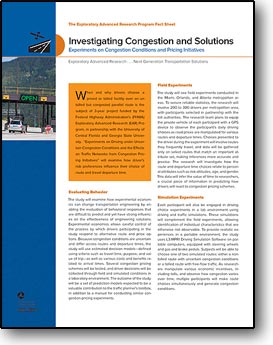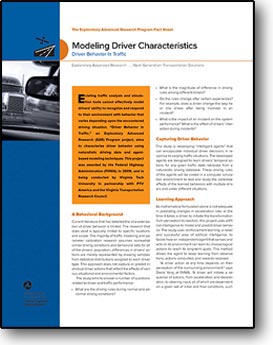















Communication Product Updates |
|---|

|
Zachary Ellis
Public Roads
March/April 2011
Compiled by Zachary Ellis of FHWA’s Office of Corporate Research, Technology, and Innovation Management
Below are brief descriptions of communications products recently developed by the Federal Highway Administration’s (FHWA) Office of Research, Development, and Technology. All of the reports are or will soon be available from the National Technical Information Service (NTIS). In some cases, limited copies of the communications products are available from FHWA’s Research and Technology (R&T) Product Distribution Center (PDC).
When ordering from NTIS, include the NTIS publication number (PB number) and the publication title. You also may visit the NTIS Web site at www.ntis.gov to order publications online. Call NTIS for current prices. For customers outside the United States, Canada, and Mexico, the cost is usually double the listed price. Address requests to:
National Technical Information Service
5285 Port Royal Road
Springfield, VA 22161
Telephone: 703–605–6000
Toll-free number: 800–553–NTIS (6847)
Web site: www.ntis.gov
Requests for items available from the R&T Product Distribution Center should be addressed to:
R&T Product Distribution Center
Szanca Solutions/FHWA PDC
13710 Dunnings Highway
Claysburg, PA 16625
Telephone: 814–239–1160
Fax: 814–239–2156
Email: report.center@dot.gov
For more information on R&T communications products available from FHWA, visit FHWA’s Web site at www.fhwa.dot.gov, the National Transportation Library’s Web site at http://ntl.bts.gov, or the OneDOT information network at http://dotlibrary.dot.gov.
Publication No. FHWA-HRT-10-052
Approximately 25 percent of fatal and injury crashes nationwide involving pedestrians and bicyclists occur on rural highways. The goals of this study, Factors Contributing to Pedestrian and Bicycle Crashes on Rural Highways, were to examine the differences between pedestrian and bicyclist crashes in urban and rural settings in North Carolina and identify problem areas (specific crash types and locations) on rural highways that are of high priority for safety treatments. This summary report discusses prior research, compares rural and urban crashes, explores factors in rural crashes, and offers conclusions.
Researchers found that rural crashes in North Carolina were typified by higher fatality rates, higher vehicle speeds, less roadway lighting, unpaved shoulders, and more nonintersection locations than urban crashes in the State. An examination of crashes by road class showed that rural, two-lane roads had the greatest need for safety improvements because of their high crash frequencies and crash rates per vehicle mile traveled.
For rural two-lane roads, the study identified 11 problem areas involving pedestrians, such as walking along roadways, and 5 bicyclist problem areas, such as turning or merging into the path of drivers midblock. Potential countermeasures to reduce pedestrian crashes in rural areas include improving roadway lighting, educating pedestrians and drivers, and adding sidewalks and paved shoulders. Potential countermeasures to reduce bicyclist crashes in rural areas include providing marked pavement space for bicyclists, adding paved shoulders, and improving roadway lighting.
The document is available at www.fhwa.dot.gov/publications/research/safety/10052/index.cfm. Printed copies are available from the PDC.
Publication No. FHWA-HRT-10-061
 When and why drivers choose a priced or tolled facility over an untolled but congested parallel route is the subject of a 3-year project under FHWA’s Exploratory Advanced Research (EAR) Program. Experiments on Driving under Uncertain Congestion Conditions and the Effects on Traffic Networks from Congestion Pricing Initiatives examined how drivers’ risk preferences influence their choices of route and travel departure times. This fact sheet discusses evaluation of driver behavior, field and simulation experiments, and expectations from the remainder of the project.
When and why drivers choose a priced or tolled facility over an untolled but congested parallel route is the subject of a 3-year project under FHWA’s Exploratory Advanced Research (EAR) Program. Experiments on Driving under Uncertain Congestion Conditions and the Effects on Traffic Networks from Congestion Pricing Initiatives examined how drivers’ risk preferences influence their choices of route and travel departure times. This fact sheet discusses evaluation of driver behavior, field and simulation experiments, and expectations from the remainder of the project.
Because congestion conditions are uncertain and differ across routes and departure times, researchers are using estimated decision models -- defined using criteria such as travel time, purpose, and the personal value of the trip -- as well as various costs and benefits related to arrival times. The researchers are testing several congestion pricing schemes and collecting data on driver decisions through field tests and simulated conditions.
The research team already has completed the design of the field and simulation experiments, which will be coordinated with agencies in the three metropolitan areas where data collection will occur -- Atlanta, GA, Miami, FL, and Orlando, FL. Preliminary tests of the procedures are underway, and full-scale pilot experiments are scheduled to be completed in 2012. The outcomes of the study will be a set of prediction models for traffic planners and a manual for conducting similar congestion pricing experiments.
The document is available at www.fhwa.dot.gov/advancedresearch/pubs/10061/index.cfm. Printed copies are available from the PDC.
Publication No. FHWA-HRT-10-060
Highway and traffic engineers often have difficulty considering how complex driver behavior will influence their designs. However, failing to calculate the impacts can cost lives and, if roadways must be rebuilt, millions of dollars. The aim of Making Driving Simulators More Useful for Behavioral Research, an EAR project, is to make driving simulators more reliable tools for highway engineers. This fact sheet discusses the state of simulation, the technical approach of driving simulators, simulation challenges, and future efforts.
The project team asserts that although existing simulators are valuable tools for research and highway design, they are underutilized because of concerns about the sometimes weak relationship between simulator data and onroad data. Researchers also cite concerns about the reliability of simulator data, given that different simulators often produce differing results for similar scenarios and design situations.
This 32-month project, launched in 2009, aims to provide a systematic, design-centered approach to matching simulator data to onroad data and correlating data between simulators. The team’s goal is to make simulators more practical and useful by creating a system to help researchers select simulator features (such as a motion base and wide visual field) that will best predict onroad performance for their particular research questions.
The document is available at www.fhwa.dot.gov/advancedresearch/pubs/10060/index.cfm. Printed copies are available at the PDC.
Publication No. FHWA-HRT-10-023
Traffic congestion costs the Nation billions of dollars each year in wasted fuel and lost productivity. Traditional traffic control systems cannot keep pace with this growing problem, but systems that work with self-driving vehicles may afford a more radical approach. FHWA’s Intersection Control for Autonomous Vehicles, an EAR project, is pursuing a new way to keep traffic moving. This fact sheet discusses the promise of autonomous vehicles, the concept of “reserving” space and time to pass through an intersection, and future efforts.
The intersection control system proposed in this EAR study promises to process traffic more efficiently than is possible with traffic lights and stop signs and without compromising safety. The system’s development is guided by a set of criteria that includes the use of current or near-term sensor technologies, the adoption of a standardized communication protocol, and the ability to deploy the new technology incrementally. These criteria allow expansion to other intersections and adaptation to increasing numbers of autonomous vehicles. Absolute collision prevention, even under conditions of communications failures, and high levels of efficiency are primary goals for the system.
The project proposes innovations in five areas: traffic signal timing, intersection collision avoidance, autonomous traffic infrastructure, autonomous driving, and multiagent systems. The project’s major tasks are developing a detailed vehicle-infrastructure communication protocol and developing and testing prototype agent-control algorithms.
The document is available at www.fhwa.dot.gov/advancedresearch/pubs/10023/index.cfm. Printed copies are available from the PDC.
Publication No. FHWA-HRT-10-070
 Existing traffic analysis and simulation tools cannot effectively model drivers’ ability to recognize and respond to situational and environmental factors. FHWA’s Driver Behavior in Traffic, an EAR project, is attempting to characterize driver behavior using naturalistic driving data and agent-based modeling techniques. This fact sheet includes background on driver behavior, how to capture driver behavior, the research’s learning approach, and future work.
Existing traffic analysis and simulation tools cannot effectively model drivers’ ability to recognize and respond to situational and environmental factors. FHWA’s Driver Behavior in Traffic, an EAR project, is attempting to characterize driver behavior using naturalistic driving data and agent-based modeling techniques. This fact sheet includes background on driver behavior, how to capture driver behavior, the research’s learning approach, and future work.
Current literature detailing the characterization of driver behavior is limited. The majority of traffic modeling and parameter calibration (adjusting a factor such as average vehicle speed to reflect real-world data) research assumes similar driving conditions and behavioral sets for all drivers. Typically, differences in drivers’ actions are represented merely by drawing samples from statistical distributions assigned to each driver type (such as sex and age). This approach does not capture or predict individual driver reactions to various situational and environmental factors.
At the conclusion of this project, FHWA will develop agents (models programmed into traffic simulators) to mimic realistic driver behavior in various driving scenarios. After the research team verifies and validates the agents, an abstraction of learned “driving rules” will be embedded in a microscopic traffic simulation tool. This study also could lead to future research to develop new generations of traffic simulation tools that can capture driver behavior in complex traffic situations accurately.
Printed copies of the fact sheet are available from the PDC.
Article reprinted from the Federal Highway Administration's January/February 2001 issue of Public Roads.
